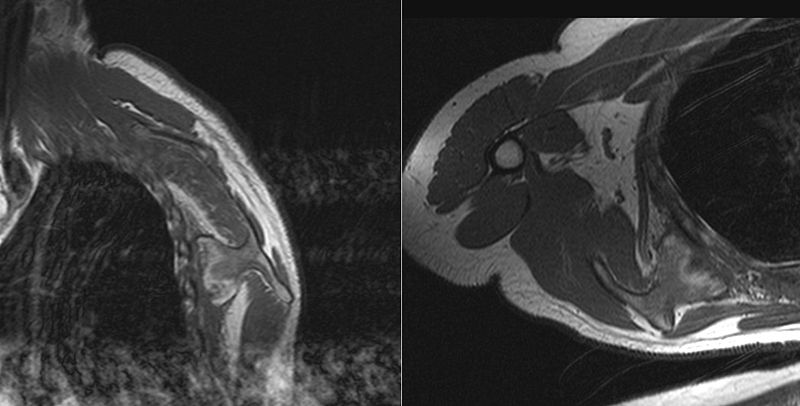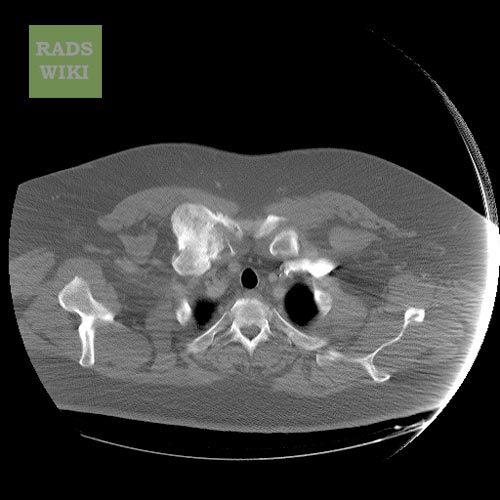Osteochondroma: Difference between revisions
m (Robot: Changing Category:DiseaseState to Category:Disease) |
No edit summary |
||
| Line 2: | Line 2: | ||
{{CMG}} | {{CMG}} | ||
== Overview == | == Overview == | ||
| Line 11: | Line 10: | ||
They often occur at joints, most commonly the [[shoulder]] or the [[knee]]. | They often occur at joints, most commonly the [[shoulder]] or the [[knee]]. | ||
[[Osteochondroma]] is not a dangerous tumor(benign). It can be left alone or can be removed by shaving down the tumor. | [[Osteochondroma]] is not a dangerous tumor(benign). It can be left alone or can be removed by shaving down the tumor. | ||
| Line 19: | Line 15: | ||
Multiple Osteochondroma (MO) is the preferred term used by the [[World Health Organization]]. | Multiple Osteochondroma (MO) is the preferred term used by the [[World Health Organization]]. | ||
==Risk Factors== | |||
Solitary osteochondroma is diagnosed in patients aged 10 to 30 years. It occurs equally in males and females. It does not result from injury. It is thought to arise during skeletal growth when bone grows away from the growth plate instead of in line with it. Because the cause of solitary osteochondroma is unknown, doctors have not been able to find a way to prevent it. | Solitary osteochondroma is diagnosed in patients aged 10 to 30 years. It occurs equally in males and females. It does not result from injury. It is thought to arise during skeletal growth when bone grows away from the growth plate instead of in line with it. Because the cause of solitary osteochondroma is unknown, doctors have not been able to find a way to prevent it. | ||
| Line 25: | Line 21: | ||
[[Image:Osteochondroma right scapula.jpg|thumb|left|600px|Osteochondroma on the ventral surface of the right scapula]] | [[Image:Osteochondroma right scapula.jpg|thumb|left|600px|Osteochondroma on the ventral surface of the right scapula]] | ||
<br clear="left"/> | <br clear="left"/> | ||
==Diagnosis== | |||
The most common symptom of an osteochondroma is a painless bump near the joints. The knee and shoulder are more commonly involved. Solitary osteochondroma can be found at the ends of any long bone, and along the pelvic and shoulder bones. If the stalk of a pedunculated osteochondroma breaks, pain and swelling may start immediately. An osteochondroma can be located under a tendon. When it is, snapping of the tissue over the tumor may cause activity-related pain. An osteochondroma can be located near a nerve or blood vessel, such as behind the knee. When it is, there may be numbness and tingling in that extremity. A tumor that presses on a blood vessel may cause periodic changes in blood flow. This can cause loss of pulse or changes in color of the limb. Changes in blood flow resulting from an osteochondroma are rare. | The most common symptom of an osteochondroma is a painless bump near the joints. The knee and shoulder are more commonly involved. Solitary osteochondroma can be found at the ends of any long bone, and along the pelvic and shoulder bones. If the stalk of a pedunculated osteochondroma breaks, pain and swelling may start immediately. An osteochondroma can be located under a tendon. When it is, snapping of the tissue over the tumor may cause activity-related pain. An osteochondroma can be located near a nerve or blood vessel, such as behind the knee. When it is, there may be numbness and tingling in that extremity. A tumor that presses on a blood vessel may cause periodic changes in blood flow. This can cause loss of pulse or changes in color of the limb. Changes in blood flow resulting from an osteochondroma are rare. | ||
<gallery> | |||
Image: | |||
Rib-osteochondroma-03.jpg|Rib-osteochondroma | |||
</gallery> | |||
==Treatment== | |||
Most of the time, solitary osteochondroma is not removed surgically. The doctor will carefully observe it. He or she may want to take regular X-rays to keep track of any changes. | Most of the time, solitary osteochondroma is not removed surgically. The doctor will carefully observe it. He or she may want to take regular X-rays to keep track of any changes. | ||
===Surgery=== | |||
When surgery is recommended, it is best to wait until growth is complete (a mature skeleton by X-ray evaluation) before removing a solitary osteochondroma. This decreases the chance of the tumor growing back. | When surgery is recommended, it is best to wait until growth is complete (a mature skeleton by X-ray evaluation) before removing a solitary osteochondroma. This decreases the chance of the tumor growing back. | ||
| Line 43: | Line 47: | ||
* Has a large cap of cartilage | * Has a large cap of cartilage | ||
The osteochondroma is removed at the level of the normal bone. Some of the inside of the bone may also be removed. | The osteochondroma is removed at the level of the normal bone. Some of the inside of the bone may also be removed. | ||
==Related Chapters== | |||
* [[Exostosis]] | |||
==References== | |||
{{reflist|2}} | |||
==External links== | ==External links== | ||
| Line 54: | Line 63: | ||
The content on this page was first contributed by: C. Michael Gibson, M.S., M.D. | The content on this page was first contributed by: C. Michael Gibson, M.S., M.D. | ||
{{WikiDoc Help Menu}} | {{WikiDoc Help Menu}} | ||
{{WikiDoc Sources}} | {{WikiDoc Sources}} | ||
Revision as of 20:09, 5 August 2012
|
WikiDoc Resources for Osteochondroma |
|
Articles |
|---|
|
Most recent articles on Osteochondroma Most cited articles on Osteochondroma |
|
Media |
|
Powerpoint slides on Osteochondroma |
|
Evidence Based Medicine |
|
Clinical Trials |
|
Ongoing Trials on Osteochondroma at Clinical Trials.gov Trial results on Osteochondroma Clinical Trials on Osteochondroma at Google
|
|
Guidelines / Policies / Govt |
|
US National Guidelines Clearinghouse on Osteochondroma NICE Guidance on Osteochondroma
|
|
Books |
|
News |
|
Commentary |
|
Definitions |
|
Patient Resources / Community |
|
Patient resources on Osteochondroma Discussion groups on Osteochondroma Patient Handouts on Osteochondroma Directions to Hospitals Treating Osteochondroma Risk calculators and risk factors for Osteochondroma
|
|
Healthcare Provider Resources |
|
Causes & Risk Factors for Osteochondroma |
|
Continuing Medical Education (CME) |
|
International |
|
|
|
Business |
|
Experimental / Informatics |
Editor-In-Chief: C. Michael Gibson, M.S., M.D. [1]
Overview
Osteochondroma is a type of benign tumor that consists of cartilage and bone.
It is the most frequently observed neoplasm of the skeleton. It is also called a "bone spur".
They often occur at joints, most commonly the shoulder or the knee.
Osteochondroma is not a dangerous tumor(benign). It can be left alone or can be removed by shaving down the tumor.
Multiple Osteochondroma (MO) is the preferred term used by the World Health Organization.
Risk Factors
Solitary osteochondroma is diagnosed in patients aged 10 to 30 years. It occurs equally in males and females. It does not result from injury. It is thought to arise during skeletal growth when bone grows away from the growth plate instead of in line with it. Because the cause of solitary osteochondroma is unknown, doctors have not been able to find a way to prevent it.

Diagnosis
The most common symptom of an osteochondroma is a painless bump near the joints. The knee and shoulder are more commonly involved. Solitary osteochondroma can be found at the ends of any long bone, and along the pelvic and shoulder bones. If the stalk of a pedunculated osteochondroma breaks, pain and swelling may start immediately. An osteochondroma can be located under a tendon. When it is, snapping of the tissue over the tumor may cause activity-related pain. An osteochondroma can be located near a nerve or blood vessel, such as behind the knee. When it is, there may be numbness and tingling in that extremity. A tumor that presses on a blood vessel may cause periodic changes in blood flow. This can cause loss of pulse or changes in color of the limb. Changes in blood flow resulting from an osteochondroma are rare.
-
Rib-osteochondroma
Treatment
Most of the time, solitary osteochondroma is not removed surgically. The doctor will carefully observe it. He or she may want to take regular X-rays to keep track of any changes.
Surgery
When surgery is recommended, it is best to wait until growth is complete (a mature skeleton by X-ray evaluation) before removing a solitary osteochondroma. This decreases the chance of the tumor growing back.
Surgery may be considered if the osteochondroma:
- Is causing pain with activity
- Puts pressure on a nerve or blood vessel
- Has a large cap of cartilage
The osteochondroma is removed at the level of the normal bone. Some of the inside of the bone may also be removed.
Related Chapters
References
External links
- BoneTumor
- American Academy of Orthopedic Surgeons
- http://orthoinfo.aaos.org/fact/thr_report.cfm?Thread_ID=474&topcategory=
Acknowledgements
The content on this page was first contributed by: C. Michael Gibson, M.S., M.D.
